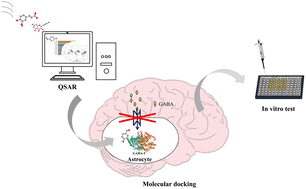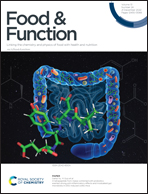Structure-guided discovery of food-derived GABA-T inhibitors as hunters for anti-anxiety compounds†
Abstract
With the acceleration of the pace of life, people may face all kinds of pressure, and anxiety has become a common mental issue that is seriously affecting human life. Safe and effective food-derived compounds may be used as anti-anxiety compounds. In this study, anti-anxiety compounds were collected and curated for database construction. Quantitative structure–activity relationship (QSAR) models were developed using a combination of various machine-learning approaches and chemical descriptors to predict natural compounds in food with anti-anxiety effects. High-throughput molecular docking was used to screen out compounds that could function as anti-anxiety molecules by inhibiting γ-aminobutyrate transaminase (GABA-T) enzyme, and 7 compounds were screened for in vitro activity verification. Pharmacokinetic analysis revealed three compounds (quercetin, lithocholic acid, and ferulic acid) that met Lipinski's Rule of Five and inhibited the GABA-T enzyme to alleviate anxiety in vitro. The established QSAR model combined with molecular docking and molecular dynamics was proved by the synthesis and discovery of novel food-derived anti-anxiety compounds.



 Please wait while we load your content...
Please wait while we load your content...